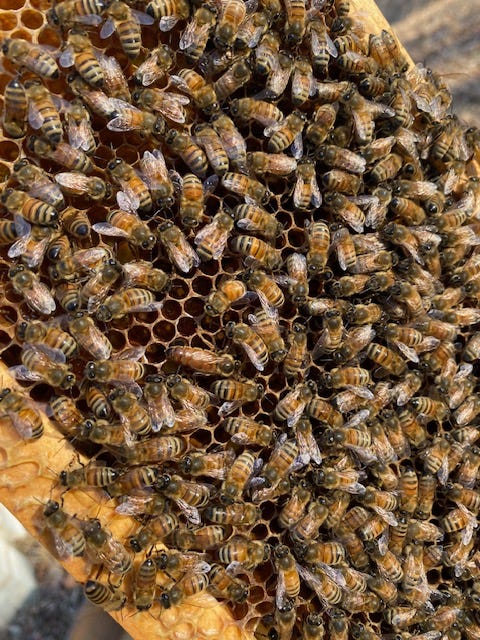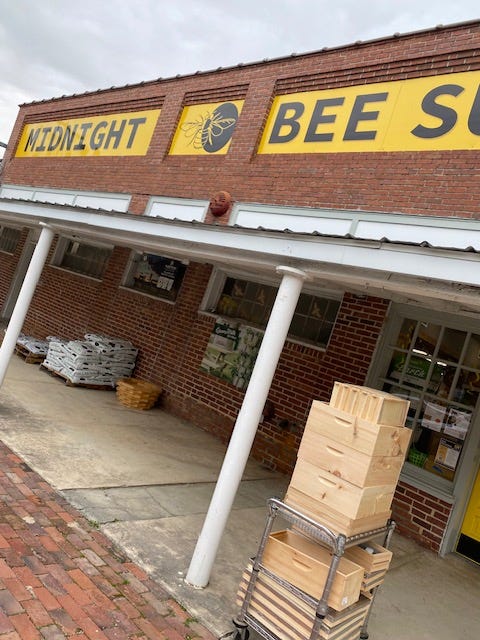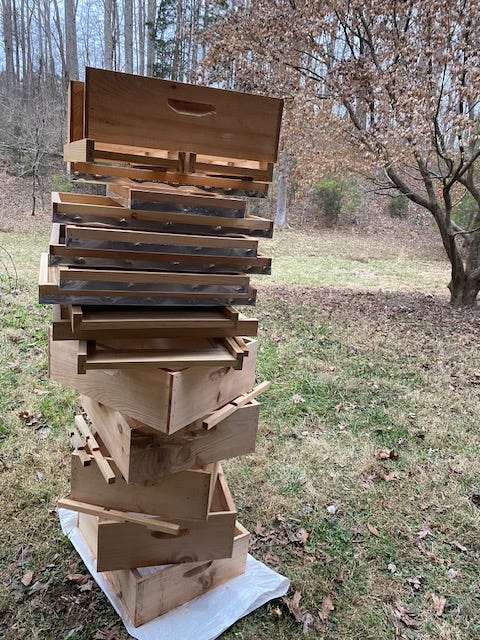7 things I do with the hives after winter to set the bees up for success
How I set the honey bees up for a successful spring.
We’re still a few weeks from the official start of spring. In these shoulder weeks, I keep an eye on the forecast to decide when I’ll do certain things in and around the hives. These actions help to prevent swarms, catch swarms, manage pests, and help the bees better manage dramatic temperature changes, which are common this time of the year. For instance, I’m drafting this post the day after we hit 80F in the afternoon, and 39F as a low less than 24 hours later. These temperature changes can impact spring brood health if colony populations didn’t stay steady throughout the winter.
I’m grateful that as of this writing, I have a 100% survival rate for all of my colonies this winter.
Before going through these hive management practices, I want to point out that I don’t take a blanket approach to keeping bees. What this means is I don’t wait for a particular day to take the same action with all hives. I’m grateful that as of this writing, I have a 100% survival rate for all of my colonies this winter. So many variables impact a colony, so I look for other signs within the colonies and also phenological signs. Phenology involves taking cues from the environment and climate. For instance, when I see dandelions bloom (an early pollen source that motivates the queen to lay), I know to keep an eye on the brood nest and add space if the queen needs more space to lay. When I start to see tulip poplar blossoms open, I make the entrances on all strong colonies as large as possible to make it easier for foragers to come and go with nectar.
Avoiding a prescriptive, blanket approach also allows for adaptability. If your goal is honey production, maybe encourage early season brood growth for your prolific layers so that your hives have more workers ready to gather nectar when the flow starts.
My goal has never been honey production, nor wax production. My goal is healthy bees. Fortunately, a symptom of a healthy colony is a good honey crop. With that context, here’s what I do before spring officially starts and what I look for in the weather and environment:

Queen hunt and potential splits. Seeing active hive entrances is a positive sign after winter, but one must find the queen to verify that the she made it through. If I see a colony without a queen, I’ll take a closer look at my next inspection. If I don’t find her or signs of her brood, then I’ll combine the colony with another that needs a boost in their population. In the event a colony doesn’t survive the winter to this point, I’ll shake out equipment and let it rest in the freezer for a few days before storing it inside.
When I choose colonies to split, I look for high brood production, and open and capped drone brood. The drone brood signals to me that other colonies in the area are likely producing drones too, so there is high potential for genetic diversity on the future queen’s mating flights.
Weather and environment: I’ll inspect on the first warm, dry day of the year, which is either high 50s or 60s. For splits, I choose a similarly warm day and I wait to see 65F+ days in the extended forecast to increase the odds of successful mating flight weather for the future queen. Of course, if I already see queen cups with brood in them, I’ll split as soon as I find the queen.Feed, when needed. One colony in my main apiary didn’t have a drop of honey. When I inspected on the first warm day of the year, the bees were moving slow and had a smaller population than the other hives—although still a strong size. Instead of making sugar syrup, I stepped over to a neighboring colony that’s still bursting with honey and “borrowed” 3 heavy frames of honey to loan to the empty colony.
Weather and environment: Before dandelions, redbud, and maple bloom, I’ll rely on bloated colonies’ honey frames to feed hives that need it.Reduce space. Now that I have an idea of who survived, on my next inspection I’ll remove as much space as possible to encourage the best population coverage across frames. A smaller space helps the bees cluster closer to food. This is a time of the year when colonies are at their smallest. All of the space they needed at the start of winter isn’t what they need now. Leaving empty space makes it easy for pests like wax moths and small hive beetles to move in—and they’re just as hungry as the bees as temperatures start to warm up.
Weather and environment: A warm day before milder temperatures.Order and organize supplies. One thing I noticed when I organized my hive equipment is that I have more bottom boards than top covers. If I had just counted bottom boards, I would have thought I could support more new colonies than I really can—I wouldn’t have had covers for them! (I remember now why there’s a mismatch: I had 2 old top covers show signs of rot and had removed them.) Also, seeing how many colonies made it through winter to this point, I know I will need to sell nucs or full hives—so I need new equipment to help move colonies around that I’ll sell. I have 2 preferences when it comes to beekeeping supplies: 1, I like to support local and regional beekeeping supply stores first, and 2, I have particular honey jars that I like to use and I like to stock up on them over the winter when there is less demand. At my main apiary in Pittsboro, North Carolina, I’m very fortunate to have a fantastic feed store less than 4 miles from home that sells beekeeping supplies, Country Farm & Home. When I need a large haul of supplies, within an hour’s drive I also have Midnight Bee Supply, Beez Needz, and Bailey Bee Supply, plus a few local garden shops with small beekeeping supply sections.
My mountain apiary near Bryson City is another story. I’m about an hour from the closest supplier (which I haven’t been to yet), and even farther from Honey & the Hive in Weaverville (such a great place) and equally far from a big supply shop in Georgia, Blue Ridge Honey.
Weather and environment: I prefer to order supplies before temperatures get consistently warm (60F daily). The warmer temperatures mean we’re moving toward swarm season, so I’ll need the extra supplies to catch swarms or to make splits. For the honey jar supplies, I won’t have time to think about that once spring hits, so I prefer having all of those jars on hand before temperatures warm up. By the time extraction days roll around, I don’t want to wait on supplies.Prepare for beetles. My small hive beetle saga has been going on for a few years. I don’t have a problem in my main apiary anymore, but my latest bee yard on the opposite side of the property is closer to a cluster of pine, which small hive beetles love. My mountain apiary chronically fights beetles because the hives are nestled in a dense pocket of pine. The most effective support in managing beetles that I’ve experienced are beneficial nematodes. These are microscopic “worms” that you apply to the ground surrounding hives and they target and feast on the beetle larvae, which grow in the ground. The nematodes work best when applied in the evening just before rain.
Weather and environment: A stretch of days with overnight lows in the 40s or higher, and a good wave of precipitation.Move hives. Since the colonies are at their smallest and lightest weight after winter, I opt to make any hive stand and relocations in February—early March at the latest. In my main apiary I’ve been slowly moving the stands into a C-shape, which studies show helps to prevent drift between colonies. My mountain apiary is at capacity, so I plan to use this time of year to expand the fencing and set up more hive stands. To set up more bee yards in the mountains I’ll need to buy a UTV to access remote areas with the equipment, so growing this space is on hold.
Weather and environment: Minimal or no nights below freezing. An actively laying queen. Ideally when I start to see pollen pants on workers. When choosing a colony to move, I want to see an almost-full brood nest so that upon relocation I can add more space right away.Choosing a varroa management plan. I routinely treat broodless splits and swarms with oxalic acid (OA) vaporization to give them a “clean slate” to start from. When it comes to overall varroa management for all of the colonies, I prefer to rotate the types of treatments. Other than OA vaporization during broodless split and swarm times, I’ve also used queen cages to create a broodless state, which breaks the varroa reproductive cycle. I’ve also used Apiguard during times of brood. In more recent years I’ve started growing more sunflowers—sunflower pollen shows promise of helping honey bees manage varroa.
You’ll notice I haven’t mentioned mite counts. I stopped doing them a few years ago because I found them inaccurate. I originally started with sugar shakes but wanted a more accurate method, so I switched to alcohol washes. That year the alcohol washes showed 0 or 1 mite counts in all colonies, so I didn’t treat. That fall I lost a few colonies to varroa—with mite drops in excess of 500+. After that experience, I prefer to skip the counts and instead rotate broodless and chemical-free treatments at strategic times.
Weather and environment: If I’m doing an OA treatment on a split or swarm, I’ll treat them within 1 week so that all brood is uncapped and exposed. OA can be used at just about any temperature, but it’s helpful to have the low end around 45F to 55F so that the colony isn’t in too tight of a cluster. It’s an ideal option on hot summer days when many other treatments can’t be used. On a recent Beekeeping Today podcast interview with Randy Oliver, Oliver shares that his research shows honey bee exposure to OA is highest in the hours after treatment, not in the few minutes after treatment, due to the extra exposure bees get from walking comb. For Apiguard, I follow the manufacturer’s guidelines for temperature and generally add the first treatment on the day that I extract honey since the honey can’t be exposed to the treatment. From my experience, I prefer treating ASAP following honey extraction to allow for healthy brood build up for winter.
How do you measure success?
Success is a great topic among beekeepers. Is a huge honey crop and then winter hive loss a success? Is survival of a colony that struggles with small hive beetles a success? Success can be relative. Let me know how you define success and how you manage your hives to get there.





